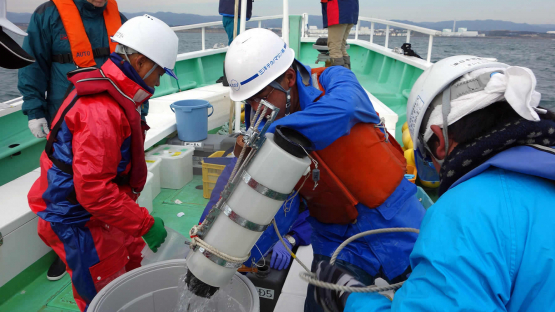Tokyo/Fukushima, 7 November 2014 – A comparison of results of sea water analysis done by the IAEA’s and Japanese laboratories, as well as a proficiency test conducted with 30 laboratories worldwide, including 12 in Japan, have shown a high level of accuracy of the data received from Japan’s laboratories, an IAEA expert told a news conference this week in Tokyo.
“The results we have obtained to date are very good and should increase confidence that the data regularly reported by Japan presents an accurate picture of the levels of radioactivity in the near-shore coastal waters east of Japan,” said David Osborn, Director of the IAEA’s Environment Laboratories in Monaco. Mr Osborn and Iolanda Osvath, Head of the Agency’s Radiometrics Laboratory in Monaco, travelled to Japan to present the results and take more water samples.
Their visit is part of the implementation of the IAEA’s recommendations on marine monitoring, outlined in the Report on the 2nd International Peer Review of Japan's Mid-and-Long-Term Roadmap towards the Decommissioning of TEPCO's Fukushima Daiichi Nuclear Power Station Units 1-4, which took place in November-December 2013.
An inter-laboratory comparison (ILC) of sea water samples collected by IAEA experts in September 2014 in the coastal waters near the Fukushima Daiichi Nuclear Power Station was conducted to compare results obtained by laboratories contracted by Japan’s Nuclear Regulation Authority (NRA) with those from IAEA laboratories.
The samples, which were analysed for radioisotopes of Cesium, were divided in two and analysed half by the IAEA and half by NRA laboratories. The results of Japan’s laboratories were found to be statistically identical with those obtained by the IAEA laboratories.
“From the results for Cesium-134 and Cesium-137 in the five sea water samples shared between Japanese and IAEA laboratories it can be concluded that the results are comparable with a high degree of confidence,” Mr Osborn said.
In a proficiency test (PT), the IAEA invites selected laboratories around the world to participate in an analysis of specific samples to compare results on the exact level of radionuclide activity. The participating laboratories are invited to analyse the samples and to send their results to the IAEA, where there are compared with the known values.
The recent PT, held from June to August 2014, was organized at the request of Japan’s NRA to test the analytical performance of participating laboratories for radionuclides in a sea water sample. A total of 30 laboratories from 15 countries participated in this exercise. This included 12 laboratories from Japan and 18 laboratories from IAEA Member States in Europe and the USA.
A particular focus of the PT was on sea water analyses of hydrogen-3, strontium-90, and cesium-134 and -137 isotopes, in relation to the Fukushima nuclear power station accident in Japan and subsequent contamination to the marine environment. The results submitted by the laboratories had to pass three different test levels before being deemed acceptable. The evaluation showed that 74 per cent of all reported results passed with “Accepted.” The 12 Japanese participants’ results showed that 86 per cent of their results were “Accepted.”
“The Japanese laboratories performed very well,” Mr Osborn said. “The results for each of the four isotopes demonstrated a high level of accuracy by the respective Japanese laboratories.”
Mr Osborn also said that the IAEA expert team would gather new samples in Fukushima for further analysis to repeat the inter-laboratory comparison. The expert team is travelling to the coastal area of the Fukushima Daiichi Nuclear Power Station on 5 and 6 November 2014.
For more information, see the IAEA experts team’s presentation here.


